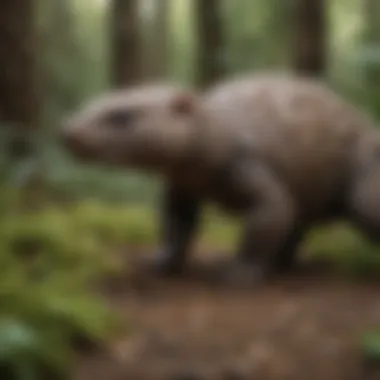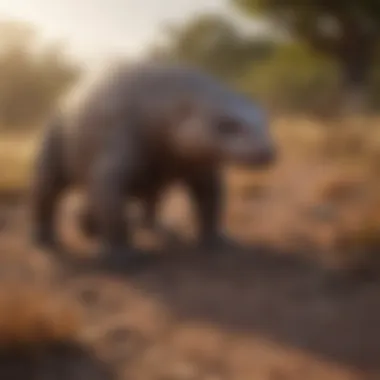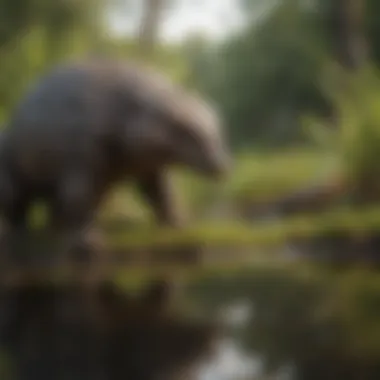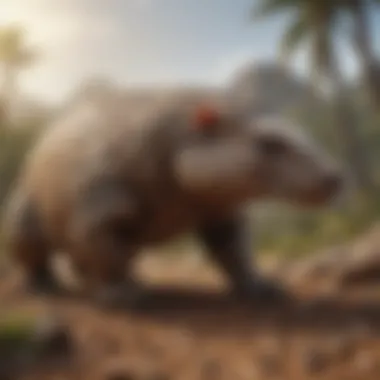Exploring the Habitats of Pangolins Worldwide


Nature Topic Overview
Pangolins are remarkable creatures that occupy a unique niche in the animal kingdom. These scaly mammals are often called the "scaly anteater" due to their diet that primarily consists of ants and termites. Understanding their habitats is essential for their survival and well-being. This article aims to explore the different environments that pangolins inhabit across the globe.
Pangolins are found on the continents of Asia and Africa. Their habitats vary from dense forests to grasslands, each offering specific resources and conditions. The geographical distribution of pangolins influences their adaptability and behavior. Knowing where they thrive helps us appreciate their ecological roles and the threats they face from habitat loss.
Key Points Covered in This Article:
- The various habitats of pangolins and their geographical spread.
- Specific conditions that allow pangolins to thrive.
- The ecological importance of pangolins in their environments.
- Challenges faced by pangolins due to habitat destruction.
- Conservation efforts to preserve their habitats.
Fun Facts and Trivia
Pangolins are fascinating animals, full of surprising traits:
- They can consume up to 70 million insects in a year.
- Their tongue can be longer than their body, helping them reach deep into ant hills.
- Pangolins can roll into a ball when threatened, using their tough scales for protection.
These fun facts can capture young readers' interests. Visuals and interactive elements, such as pictures of pangolins in their natural habitats, can enhance understanding and engagement.
Wildlife Explorations
Pangolins share their habitats with many other species. For example, in tropical forests, they may come across elephants, monkeys, and numerous birds. Each of these animals plays a role in the ecosystem, and they can be affected by changes in the environment.
Here are some animals that can be found in similar habitats:
- Asian Elephants: These large mammals roam the forests, creating paths that help other animals.
- Sun Bears: Known for their long tongues and love for honey, they share similar diets with pangolins but prefer a different food source.
Exploring these cohabiting species can provide a richer understanding of the complexities of ecosystems. Interactive quizzes can also help reinforce what children learn about these animals.
Environmental Awareness
Conservation is vital for ensuring the survival of pangolins and their habitats. The destruction of forests leads to habitat loss, which is a significant threat to these animals. Parents and children can work together to help protect nature by:
- Supporting wildlife conservation organizations.
- Reducing waste to help keep environments clean.
- Learning about local wildlife and their needs.
Encouraging young readers to take action fosters a sense of responsibility towards the environment.
DIY Nature Activities
Engaging in hands-on activities can deepen understanding of nature. Here are some suggestions:
- Create a nature journal: Children can draw pictures of animals they see in parks or gardens, including pangolins.
- Pangolin habitat diorama: Use materials like cardboard to build a small model of a pangolin's natural habitat.
- Outdoor scavenger hunt: Create a list of things to find in nature, like different leaves or insects, simulating what a pangolin might seek out.
These activities encourage exploration and creativity while learning about pangolins and their environments.
Prologue to Pangolins
Pangolins are fascinating creatures that hold a unique place in the animal kingdom. They are often called "scaly anteaters" due to their remarkable armor made of keratin, the same material as human nails. This introduction to pangolins is not just about what they look like but also about their ecological role and the threats they face.
Understanding pangolins is essential because they are among the most trafficked mammals in the world. Their scales are used in traditional medicine, leading to a significant decline in their populations. By exploring their habitats, we uncover the reasons that make these environments vital for their survival. Learning about where pangolins live can help foster a deeper appreciation for these animals and underline the urgent need for conservation efforts.
Overview of Pangolin Species
There are eight species of pangolins, found across Asia and Africa. Some of these include the Chinese pangolin and the Giant pangolin. Each species has adapted well to its environment. For instance, Asian pangolins tend to inhabit forests, while African pangolins can be found in savannas and grasslands. These different habitats offer distinct challenges and opportunities for each species.
In recent years, pangolin populations have dramatically decreased, raising concerns among conservationists. Protecting the specific habitats where these animals thrive is crucial for their recovery. This section aims to outline these species in detail, highlighting their distinctions and the specific geographical regions where they are prevalent.


Physical Characteristics
Pangolins are known for their unique physical attributes. They have hard, overlapping scales that cover their bodies, providing protection from predators. These scales are made of keratin and can account for roughly 20% of their body weight. They also have long, curling tongues, which can extend up to 16 inches, allowing them access to ants and termites, their primary food sources.
The size of pangolins varies, with some species weighing less than 2 pounds and others, like the Giant pangolin, reaching up to 70 pounds. Their strong forelimbs and claws help them dig into termite mounds or burrows, making it easier to find food. This adaptability in their feeding habits is what allows them to occupy different habitats successfully, from dense forests to open grasslands.
Pangolins play a critical role in their ecosystem. By consuming insects, they help regulate insect populations, promoting balance in their environments.
In summary, understanding the physical characteristics of pangolins offers insight into how they interact with their habitats and why these specific environments are integral to their survival. Learning more about their biology not only informs conservation strategies but also helps raise awareness about the challenges these species face in today’s changing world.
Geographical Distribution
Understanding the geographical distribution of pangolins is essential to grasp their survival and the conservation efforts needed. Pangolins inhabit diverse environments, and their presence across different continents provides vital insights into their adaptability and ecological roles. This section will explore where these unique creatures can be found and why their habitats are crucial for their well-being.
Continental Presence
Pangolins are present across multiple continents, mainly in Asia and Africa. Each continent hosts distinct species that are adapted to specific ecological conditions. In Asia, the Indian pangolin and the Sunda pangolin thrive in forested regions and grasslands, while in Africa, the African pangolins are abundant in savannahs and forests. The variation in landscape influences their behavior, diet, and interaction with the ecosystem.
The intercontinental differences also expose the risks that pangolins face. For example, Asian pangolins encounter habitat loss due to urban expansion and agriculture, while African species face threats from poaching and habitat degradation. Consequently, it is critical to understand these regional dynamics for effective conservation strategies.
Country-Specific Habitats
Each country where pangolins exist offers specific habitats that support their needs. In India, pangolins are often located in scrublands and grasslands. In Southeast Asia, countries like Indonesia and Malaysia provide dense forests full of ants and termites, which are staple foods for pangolins. Conversely, in African nations such as the Democratic Republic of the Congo, they can be found in both grasslands and dense, humid forests.
Understanding these country-specific habitats can help support tailored conservation plans focusing on local ecosystems, ensuring pangolins have adequate food sources and shelter.
Pangolins in Asia
In Asia, pangolins inhabit varied environments from the tropical forests of Indonesia to the dry grasslands of India. They play a vital role in controlling insect populations, as they primarily feed on ants and termites. The Indian pangolin, found throughout the subcontinent, thrives in areas with plenty of insects. Meanwhile, the Sunda pangolin, which resides in Southeast Asia, prefers forests where it can easily dig into ant hills.
Despite their adaptive traits, Asian pangolins are heavily impacted by poaching and habitat destruction. These threats not only reduce their populations but also disrupt the ecosystems they help sustain.
Pangolins in Africa
African pangolins, including the ground pangolin and the tree pangolin, occupy different habitats ranging from savannahs to forests. Their presence is essential for maintaining healthy ecosystems by regulating insect populations. In these areas, pangolins contribute to soil health through their burrowing activities. Their digging stirs the soil and allows for better water infiltration and plant growth.
Unfortunately, African pangolins face similar threats as their Asian counterparts. Poaching for their scales and meat is rampant. Additionally, habitat loss from agricultural expansion further threatens their survival.
"Pangolins are crucial for maintaining ecological balance. They should be protected for our ecosystem's health."
In summary, the geographical distribution of pangolins across continents and within countries illustrates not only their adaptability but also the necessity of habitat preservation to ensure their survival.
Preferred Habitat Types
Understanding the preferred habitat types of pangolins is central to comprehending their survival and ecological roles. These habitats provide the necessary resources for foraging and shelter, enable safe breeding, and facilitate movements. Each habitat type offers its own unique benefits, essential for the overall health and stability of pangolin populations. By studying where pangolins thrive, we not only gain insight into their life needs but also underscore the importance of protecting these environments.
Forest Environments
Pangolins primarily inhabit forest environments, which provide lush vegetation and abundant food sources. The dense underbrush allows them to hide from predators while they search for ants and termites, their main source of food. Forests contribute essential elements to pangolin life. The tall trees aid in temperature regulation, while fallen leaves and logs provide ample hiding spots and moist soil conditions that support insect life.
Additionally, forests contribute to ecological health. They stabilize the soil and reduce erosion, maintaining balance in the ecosystem. Pangolins, as insectivores, also play a crucial role in controlling insect populations, thus supporting forest health.
Grasslands and Savannas
Grasslands and savannas are also significant habitats for certain pangolin species. These areas present a different kind of environment, favoring open spaces where pangolins use their keen sense of smell to locate food. The lack of dense forest allows for easier movement and reduces the risk of predation from larger animals.
In grasslands, pangolins often dig into the soil to reach their prey. The combination of grasses and occasional trees provides necessary cover. These habitats also support a diverse range of animal life, indicating complex ecological interactions. Through their foraging activities, pangolins contribute to nutrient cycling within these ecosystems.


Urban Areas
Urban areas may seem unfit for wildlife, but pangolins have been known to adapt to some urban environments. They seek out green spaces, gardens, and even parks. This adaptability underscores their resilience but also highlights significant challenges. Access to food is not always consistent, and human interference can lead to increased dangers from traffic and poaching.
Nonetheless, pangolins can reside in these areas, showcasing their ability to live in proximity to humans. Urban settings raise awareness about wildlife conservation, as residents can engage in protective efforts. Informing your community about local pangolin populations can make a significant difference.
"Understanding pangolins’ preferred habitats is essential for their conservation success. Protecting these environments ensures their survival and the health of the ecosystems they inhabit."
By recognizing the unique characteristics of each preferred habitat, we can better appreciate the importance of conserving these spaces for pangolins and the overall health of the ecosystems they support.
Ecological Significance of Pangolin Habitats
The habitats of pangolins are essential not only for their survival but also for the larger environment. Understanding how these environments function allows us to appreciate the role pangolins play within the ecosystem. Their presence can enhance biodiversity, control insect populations, and contribute to nutrient cycling in the soil. Pangolins, through their foraging behaviors, can create spaces for various flora and fauna. This interaction shows the need to protect these specific habitats to ensure pangolins and the ecosystem continue to thrive.
Role in Ecosystem Function
Pangolins serve unique functions within their ecosystems. They primarily feed on ants and termites, which makes them vital in regulating these insect populations. This feeding process helps to maintain the balance of ecosystems. When pangolins dig into the soil to find food, they aerate it. This action aids in promoting healthy soil structure and increases water infiltration, which is crucial during dry seasons.
Additionally, by consuming large quantities of ants and termites, pangolins reduce the risk of these insects overpopulating and damaging plant life. Thus, pangolins help sustain the health of the forests and grasslands where they live. Their role is often underappreciated but is clearly woven into the fabric of their habitats.
Impact on Soil and Plant Health
The activity of pangolins has a direct effect on soil health. Their digging behavior exposes nutrient-rich soil layers, allowing for better soil aeration. This process contributes to the overall cycling of nutrients and enhances the growth of plants.
When pangolins consume insects, they also play a part in controlling pests that would otherwise harm vegetation. This control not only helps plants thrive but also supports other organisms that depend on those plants for food and shelter.
The habitats where pangolins forage tend to be more vibrant and healthier ecosystems because of this animal's influence. An environment with healthy soil due to the activities of pangolins is more likely to support diverse plant life, which in turn supports various animal species.
The health of pangolin habitats directly correlates to the well-being of the biodiversity they support.
Threats to Pangolin Habitats
Pangolins, often referred to as the world’s most trafficked mammals, face numerous challenges that threaten their natural habitats. Understanding these threats is crucial for the conservation of these unique creatures. These threats are varied and interconnected, impacting not only pangolins but also the broader ecosystems they inhabit. Below, we explore key elements such as deforestation, urbanization, and climate change that contribute to habitat loss.
Deforestation
Deforestation is one of the primary threats to pangolin habitats. This occurs when forests are cleared for agriculture, logging, or urban development. As trees are removed, the delicate balance of the ecosystem is disturbed. Pangolins rely on forests for both food and shelter. They feed primarily on ants and termites, which are often abundant in wooded areas. With the loss of trees, the food resources become scarce.
In addition to the direct loss of habitat, deforestation also fragments the remaining landscapes. This fragmentation isolates pangolin populations, making it harder for them to find mates and decreasing genetic diversity. It also exposes them to predators and human interactions, both of which can further threaten their survival.
Urbanization
Urban expansion poses another significant risk to pangolin habitats. As cities grow, natural areas are replaced by buildings and roads. This not only destroys the homes of pangolins but also limits their ability to roam freely. Urban areas can invite poaching, as illegal wildlife trade becomes more accessible in densely populated regions.
Moreover, urbanization often leads to increased pollution and noise, both of which can disturb pangolin behavior. They become less likely to forage for food, and their reproductive rates may decline. Urban habitats do not effectively support the life cycles of pangolins as well as their natural environments do.
Climate Change Effects
Climate change brings long-term consequences that affect pangolin habitats. Fluctuating temperatures and erratic weather patterns can disrupt the ecosystems pangolins depend on. For example, droughts can reduce the population of ants and termites, leading to food shortages. In contrast, heavy rains and flooding can destroy nesting areas.
Furthermore, climate change threatens the overall biodiversity of ecosystems. As species migrate or become extinct, the ecological balance shifts. Pangolins may find it increasingly difficult to survive as their habitats change. The loss of suitable environments will force them to adapt to new conditions, which may not happen quickly enough for the species to thrive.
"Understanding these threats is essential not only for pangolins but also for preserving the entire ecosystem they are part of."
Conservation Efforts


Conservation efforts for pangolins are essential in the fight against their extinction. They are the most trafficked mammals due to the demand for their scales and meat. Protecting pangolins means stabilizing their habitats and ensuring their survival for future generations. Each aspect of conservation plays a role.
Protected Areas
Protected areas serve as safe havens for pangolins and other wildlife. These regions can include national parks, reserves, and wildlife sanctuaries. By safeguarding these spaces, we provide pangolins with the opportunity to thrive in environments free from human disruption.
- Benefits of Protected Areas:
- Habitat Safety: They reduce the risk of poaching and habitat destruction.
- Biodiversity Preservation: Protected areas support diverse ecosystems, helping many species coexist.
- Research Opportunities: These areas offer scientists a chance to study pangolins in their natural habitat, contributing to better conservation strategies.
Legislation and Policies
Legislation and policies are crucial in protecting pangolins. Laws specifically designed to combat poaching and illegal wildlife trade help to protect these mammals.
- CITES: The Convention on International Trade in Endangered Species restricts trade of pangolins to prevent their exploitation.
- Local Laws: Countries can establish stricter penalties for poaching and trafficking pangolins. These laws must be enforced to have an effect.
"Effective legislation is key to safeguarding vulnerable species like pangolins from further decline."
Community Involvement in Conservation
Engaging local communities in conservation is vital. When communities understand the importance of pangolins, they can become advocates for their protection.
- Education Programs: Teaching communities about the ecological role of pangolins encourages conservation.
- Sustainable Alternatives: Providing alternatives to hunting allows communities to still thrive economically without harming pangolin populations.
- Participation in Conservation Efforts: Local involvement in monitoring pangolin populations can empower communities.
Conserving pangolins involves a collective effort from individuals, organizations, and governments. Each of these elements plays a fundamental role in the survival of this unique species.
Future Perspectives
Understanding the future perspectives for pangolins and their habitats is crucial in the broader context of global biodiversity and conservation efforts. As we look forward, the dynamics surrounding these unique creatures and their environments continue to evolve. Assessing the potential future has several important aspects, including identifying research directions and instilling a sense of personal responsibility within communities.
Research Directions
Research plays a pivotal role in the conservation of pangolins and their habitats. Future studies should focus on several key areas:
- Habitat Assessment: It is essential to identify and monitor the health of various habitats that pangolins occupy. This knowledge helps determine which areas are most at risk and what conservation strategies might be effective.
- Population Studies: Understanding pangolin population dynamics is necessary. This includes studying breeding patterns and factors contributing to population declines, which can inform effective conservation strategies.
- Impact of Climate Change: With climate change creating unpredictable environments, research should address how changing conditions affect pangolin habitats. Insights from such studies can assist in creating mitigation strategies.
- Ecological Interactions: Investigating the role of pangolins in their ecosystems can provide valuable information on how they contribute to ecological balance. This understanding can lead to better protection and management strategies.
These research directions can enhance our understanding and provide the tools needed to protect pangolins effectively. More scientists, environmentalists, and policymakers should work together to analyze and share their findings for the greater good.
Personal Responsibility and Awareness
Individual actions significantly influence the future of pangolins. Increasing personal responsibility and awareness is critical. Here are some steps individuals can take:
- Education: Knowledge about pangolins and their ecological role is vital. Educating children and adults can foster a culture of empathy and stewardship towards all wildlife.
- Sustainable Practices: Adopting sustainable habits at home can have a positive effect. Reducing plastic use, recycling, and supporting eco-friendly products can lessen the overall impact on natural habitats.
- Supporting Conservation Efforts: Individuals can contribute through donations or volunteer work with organizations focused on wildlife conservation. By supporting these efforts, communities can help safeguard pangolin habitats.
- Advocacy: Raising awareness and advocating for better policies regarding wildlife protection can lead to tangible changes. Individuals can participate in campaigns that call for stronger conservation laws and protections.
By taking personal responsibility and being aware of the impacts of our actions, communities can create a supportive environment that fosters the survival of pangolins and their habitats. Together, informed and responsible individuals can play a significant role in shaping a better future for these unique creatures.
Closure
The conclusion of this article highlights essential insights into the habitats of pangolins. Understanding where these unique creatures live is fundamental to grasping their ecological roles and the challenges they face. The key points discussed throughout shed light on the geographical distribution, preferred habitat types, and the ecological significance of pangolin habitats. By summarizing this information, we underline the interconnectedness of habitat health and the survival of pangolin species.
Summary of Key Points
In this section, we recapitulate critical aspects of the article:
- Geographical Distribution: Pangolins are found mainly in Africa and Asia, inhabiting diverse environments, including forests and grasslands.
- Preferred Habitat Types: Different pangolin species have unique habitat preferences, often occupying forests, savannas, and sometimes urban areas.
- Ecological Significance: Pangolins contribute significantly to their ecosystems by controlling insect populations and promoting soil health.
- Threats to Habitats: Deforestation, urbanization, and climate change severely impact pangolin habitats, leading to their decline.
- Conservation Efforts: Initiatives such as protected areas and community involvement aim to conserve pangolin habitats and ensure their survival.
Call to Action for Conservation
Awareness and action are crucial in the fight to conserve pangolin habitats. Here are some steps we can take:
- Support Organizations: Contribute to wildlife organizations working to protect pangolins and their habitats.
- Educate Others: Share knowledge about pangolins and the importance of habitat preservation with friends and family.
- Adopt Sustainable Practices: Encourage sustainable land-use practices and support policies that protect natural habitats.
- Report Illegal Trade: Be vigilant against illegal trafficking of pangolins and report any suspicious activities.
Each action, no matter how small, contributes to the larger effort of conservation. Together, we can ensure that pangolins continue to thrive in their natural habitats.







